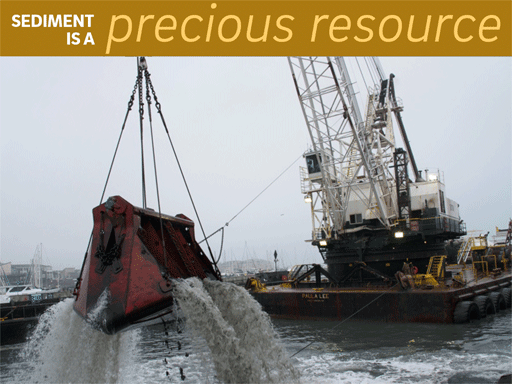SEDIMENT
Dredged and excavated sediment is a resource, not a waste product
 As sea level rises, the accumulation of sediment in the baylands is essential for their resilience over time and the ongoing provision of the multiple benefits they provide to the Bay Area. Unfortunately, the sediment supply in the Bay dropped significantly around the run of the past century and is now insufficient to keep baylands healthy over the next century.
As sea level rises, the accumulation of sediment in the baylands is essential for their resilience over time and the ongoing provision of the multiple benefits they provide to the Bay Area. Unfortunately, the sediment supply in the Bay dropped significantly around the run of the past century and is now insufficient to keep baylands healthy over the next century.
As a consequence, we will need to take steps to make sediment available for the baylands. This means restoring the natural processes that provide sediment (freshwater flows from upland areas and tidal flows from the Bay), and also thinking differently about the sediment we handle. While in the past we have treated dredged or excavated sediment as a waste to be managed, we now must treat it as a resource to be allocated (where not contaminated with chemicals that require careful disposal).
These management changes, which have already begun in our region, include using sediment that is dredged from shipping channels and flood control channels or excavated from upland areas to help build the baylands of the future. Large diked areas in the baylands have subsided below current sea level; sediment must be used to bring these areas up to the proper elevation so that marshes and mudflats can get established when the tides are restored.
There is still uncertainty regarding the amount of sediment required for the ongoing survival and health of the baylands. More research and monitoring will be needed to quantify (1) all potential sediment sources to the baylands, in particular their amounts and patterns of delivery in space and time, and (2) sediment transport and fate in baylands ecosystems, particularly mudflats and marshes. This type of research will help us refine our understanding of whether there will be enough sediment to maintain current marshes, mudflats, and managed ponds under specified sea-level rise projections, watershed management approaches, and sediment-supply parameters.
See The Baylands and Climate Change sections: The Dynamic Workings of the Baylands and Projected Evolution of Baylands Habitats in Chapter 1, and Regional Actions 1, 7, and 8 in Chapter 2.
